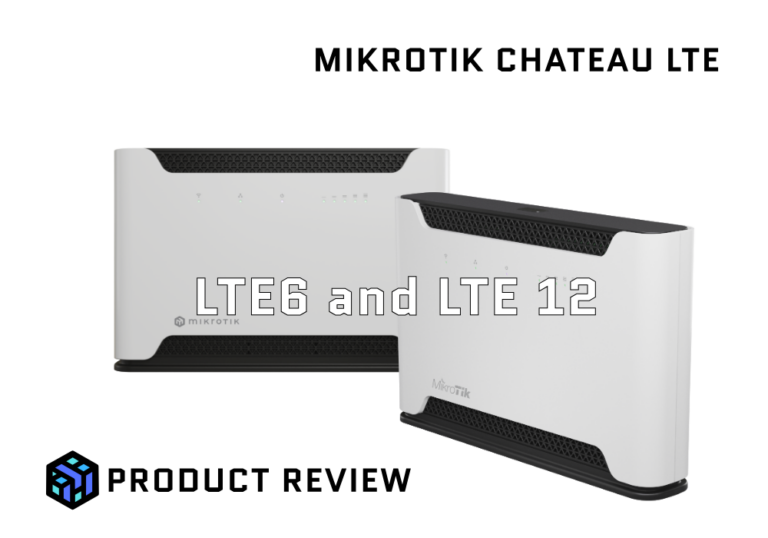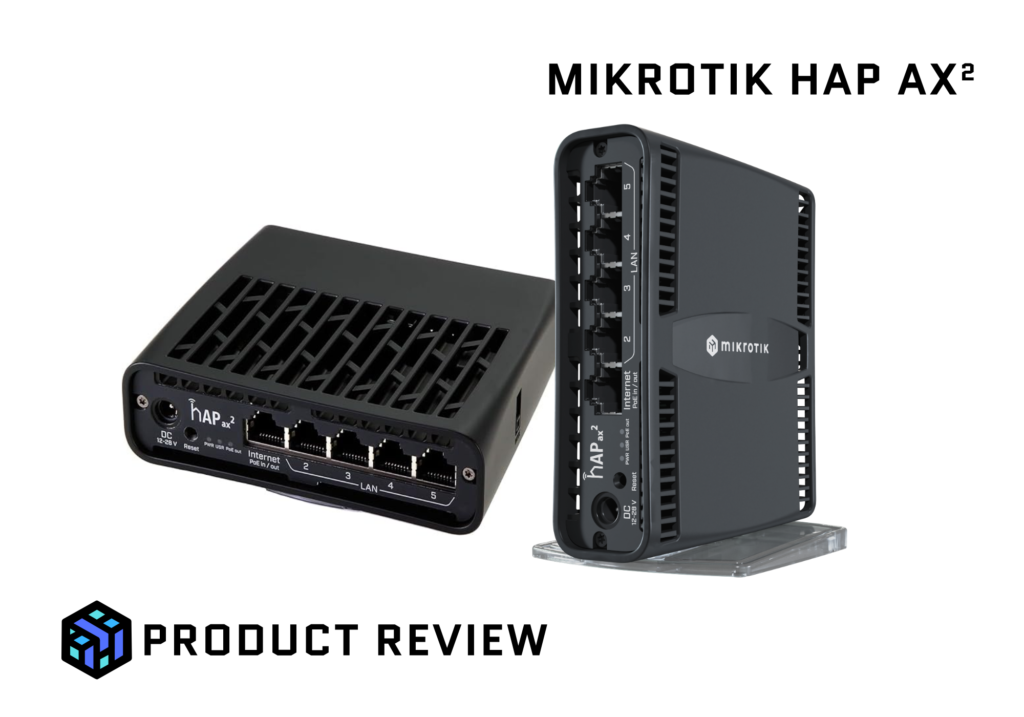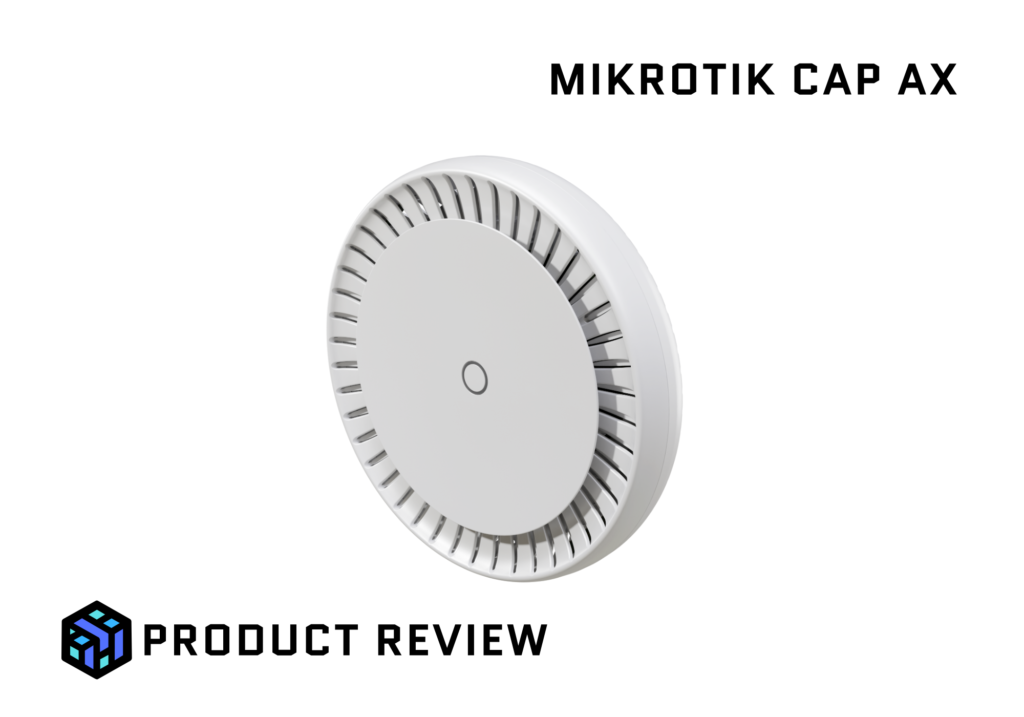The MikroTik Chateau LTE 6 and Chateau LTE 12 are dual-band home routers and access points designed to provide robust internet connectivity through LTE networks. Both devices offer a range of features suitable for various user needs. Below is a detailed review of each product, followed by a comparison of their specifications and use cases.
MikroTik Chateau LTE 6
The Chateau LTE 6 is equipped with a CAT6 LTE modem, enabling carrier aggregation for improved data rates and better performance in areas with high LTE usage. It supports download speeds up to 300 Mbps and upload speeds up to 50 Mbps. The device features dual-band Wi-Fi with 2.4 GHz (802.11b/g/n) and 5 GHz (802.11a/n/ac) frequencies, offering maximum data rates of 300 Mbps and 867 Mbps, respectively. The 2.4 GHz band utilises a dual-chain setup with 2 dBi antenna gain, while the 5 GHz band also employs a dual-chain configuration with 4 dBi antenna gain.
Powered by a quad-core ARM 32bit CPU (IPQ-4019) with a nominal frequency ranging from 488 to 896 MHz, the Chateau LTE6 includes 256 MB of RAM and 16 MB of flash storage. It offers five Gigabit Ethernet ports and one USB type A port, providing flexibility for wired connections and peripheral integration. The device operates on RouterOS v7, delivering advanced networking capabilities suitable for both novice users and IT professionals.
MikroTik Chateau LTE 12
The Chateau LTE 12 features a CAT12 LTE modem, allowing for carrier aggregation across three bands simultaneously. This capability supports download speeds up to 600 Mbps and upload speeds up to 150 Mbps, offering enhanced performance in crowded environments and areas with weaker signals. Similar to the LTE6 model, it provides dual-band Wi-Fi with 2.4 GHz (802.11b/g/n) and 5 GHz (802.11a/n/ac) frequencies, achieving maximum data rates of 300 Mbps and 867 Mbps, respectively. The 2.4 GHz band has a dual-chain setup with 3 dBi antenna gain, while the 5 GHz band maintains a dual-chain configuration with 4 dBi antenna gain.
This model is powered by the same quad-core ARM 32bit CPU (IPQ-4019) with a nominal frequency between 448 and 896 MHz, accompanied by 256 MB of RAM and 16 MB of flash storage. It also includes five Gigabit Ethernet ports and one USB type A port. Operating on RouterOS v7, the Chateau LTE12 offers comprehensive networking features suitable for a wide range of users.
Comparsion
The MikroTik Chateau LTE6 and Chateau LTE12 are dual-band home access points designed to provide reliable internet connectivity via LTE networks. Both devices offer distinct features catering to various user requirements. Below is a detailed comparison of their specifications, including supported LTE bands, to assist in understanding their capabilities and determining the suitability of the more expensive unit.
Comparison of Specifications
| Feature | Chateau LTE6 | Chateau LTE12 |
|---|---|---|
| LTE Category | CAT6 (300 Mbps DL / 50 Mbps UL) | CAT12 (600 Mbps DL / 150 Mbps UL) |
| Carrier Aggregation | Yes, two bands | Yes, three bands |
| LTE FDD Bands | 1 (2100 MHz), 3 (1800 MHz), 5 (850 MHz), 7 (2600 MHz), 8 (900 MHz), 20 (800 MHz), 28 (700 MHz) | 1 (2100 MHz), 3 (1800 MHz), 5 (850 MHz), 7 (2600 MHz), 8 (900 MHz), 20 (800 MHz), 28 (700 MHz) |
| LTE TDD Bands | 38 (2600 MHz), 40 (2300 MHz), 41 (2500 MHz) | 38 (2600 MHz), 40 (2300 MHz), 41 (2500 MHz) |
| 3G Bands | 1 (2100 MHz), 3 (1800 MHz), 5 (850 MHz), 8 (900 MHz) | 1 (2100 MHz), 3 (1800 MHz), 5 (850 MHz), 8 (900 MHz) |
| Wi-Fi Standards | 2.4 GHz: 802.11b/g/n 5 GHz: 802.11a/n/ac | 2.4 GHz: 802.11b/g/n 5 GHz: 802.11a/n/ac |
| Max Wi-Fi Data Rates | 2.4 GHz: 300 Mbps 5 GHz: 867 Mbps | 2.4 GHz: 300 Mbps 5 GHz: 867 Mbps |
| Antenna Gain | 2.4 GHz: 2 dBi 5 GHz: 4 dBi | 2.4 GHz: 3 dBi 5 GHz: 4 dBi |
| CPU | Quad-core ARM 32bit (IPQ-4019), 488-896 MHz | Quad-core ARM 32bit (IPQ-4019), 448-896 MHz |
| RAM | 256 MB | 256 MB |
| Storage | 16 MB Flash | 16 MB Flash |
| Ethernet Ports | 5 x Gigabit | 5 x Gigabit |
| USB Ports | 1 x USB type A | 1 x USB type A |
| Operating System | RouterOS v7 | RouterOS v7 |
Use Cases and Considerations
Both models support the same LTE FDD and TDD bands, ensuring compatibility with a wide range of network providers. The key difference lies in their LTE categories:
- Chateau LTE6: With CAT6 capabilities, it supports carrier aggregation across two bands, offering download speeds up to 300 Mbps. This model is suitable for users with moderate internet usage in areas with stable LTE coverage.
- Chateau LTE12: Featuring CAT12 capabilities, it allows carrier aggregation across three bands, providing download speeds up to 600 Mbps. This makes it ideal for users requiring higher bandwidth, such as for streaming high-definition content or supporting multiple devices simultaneously, especially in areas with high LTE congestion.
Choosing the More Expensive Unit
Opting for the more expensive Chateau LTE12 is advantageous if your use case demands higher LTE throughput and better performance in challenging network conditions. The advanced CAT12 modem with triple-band carrier aggregation offers significant improvements in speed and reliability, making it suitable for bandwidth-intensive applications and environments with heavy network traffic. However, if your internet usage is moderate and you’re in an area with stable LTE coverage, the Chateau LTE6 may adequately meet your needs.




